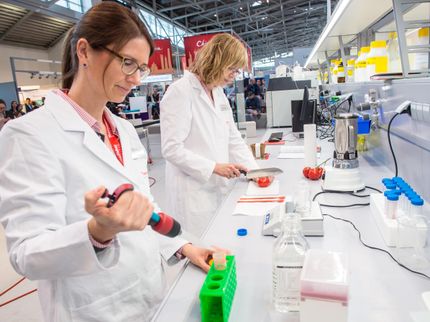First comparative study on automated analysis methods of large data sets in microplastics research
The lack of uniform analytical standards currently prevents the comparability of data on microplastics in the environment. Researchers from the University of Bayreuth and the Alfred Wegener Institute, Helmholtz Centre for Polar and Marine Research (AWI) have now, for the first time, compared two automated analysis procedures for microplastic data with regard to the results. Significant deviations were found especially for small particles with comparatively high hazard potential. The study, published in the journal Analytical and Bioanalytical Chemistry, shows that the standardization of analytical procedures must be a key research goal.

Symbolic image
Computer-generated image
Particles of plastic are called microplastics if they are smaller than five millimeters. In the early days of research, microplastics were identified on the basis of purely visual criteria alone. The decision as to whether a suspect particle was microplastic was therefore based on the individual perception of the researchers. However, this can lead to highly erroneous results. It is now clear that, especially for small microplastic particles, only identification by chemical analysis provides robust data on microplastics. Micro-Fourier transform infrared spectroscopy – in short: micro-FTIR spectroscopy – is currently one of the most reliable measurement methods in this field. To investigate microplastic particles smaller than 0.5 millimeters, the samples must be applied to filters and can then be analyzed using micro-FTIR spectroscopy. Here, the complete sample filter is measured with a high resolution. This creates a "chemical map" of the filter, which makes it possible to clearly identify microplastics down to a size of ten micrometers. However, the measurement produces up to several million FTIR spectra, making manual analysis for microplastics impossible. Reliable automated computer methods are required for such an analysis.
For the automatic analysis of FTIR data sets, various evaluation algorithms are used in microplastics research today. Two well-established and frequently used algorithms for the identification of microplastic FTIR spectra have been developed independently by the AWI and the University of Bayreuth: the siMPle analysis tool (systematic identification of MicroPlastics in the environment) and the BPF (Bayreuth Particle Finder). Both algorithms have the advantage that the large measurement data can be examined in their entirety. This avoids biases that arise when only parts of a sample are selected and the analysis results are extrapolated to the entirety of the sample.
As part of their comparative study, the researchers at the University of Bayreuth and at the Helgoland site of the AWI examined two sets of samples with both evaluation algorithms. The quantity and size of the microplastic particles and the proportions of various polymers were measured. One sample set contained ten water samples from the Upper and Middle Weser, the other sample set ten water samples originating from the Lower/Outer Weser and the Jade Bay. "We deliberately chose to conduct our comparison of the two analytical tools with sample sets from the environment, because all environmentally relevant types, shapes and sizes of polymers are encountered here. In addition, the very small microplastic particles are particularly common in the environment, and the smaller the particles are, the higher their hazard potential. This makes it all the more important to evaluate the latest methods such as micro-FTIR spectroscopy and automated analysis of FTIR data sets, which are suitable for investigations of these particles," says Prof. Dr. Christian Laforsch, spokesman of the SFB "Microplastics" at the University of Bayreuth and corresponding co-author of the study.
For the new study, the researchers in Bayreuth and Helgoland compared the results obtained in parallel with the two analysis tools. Overall, the results are largely consistent. But there are also deviations: Especially in the range of particles smaller than 50 micrometers, there are different results, because here the algorithms can also make wrong decisions as a result of poorer FTIR spectra quality. "Our study shows that further comparative research is needed so that microplastic particles of all sizes can be identified without error using automated methods. Results obtained so far on the contamination of the environment by microplastics should definitely be viewed with a certain degree of skepticism, especially with regard to smaller size classes. Furthermore, our study proves that we obtain good and robust data when we finally subject the data obtained with the analysis tools to a critical review," says co-author Dr. Martin Löder from the University of Bayreuth. "However, with all the techniques and methods currently in use, it ultimately remains unclear how well the results obtained in the process reflect the actual microplastic loads in the environment. Even if we use modern, technically advanced investigation methods, the question of how many and which microplastic particles actually pollute the environment cannot yet be answered conclusively. Particularly in the case of the very small particles, we are still at the very beginning here, which makes further research efforts all the more important," emphasizes Prof. Dr. Christian Laforsch.
Original publication
Other news from the department science

Get the analytics and lab tech industry in your inbox
By submitting this form you agree that LUMITOS AG will send you the newsletter(s) selected above by email. Your data will not be passed on to third parties. Your data will be stored and processed in accordance with our data protection regulations. LUMITOS may contact you by email for the purpose of advertising or market and opinion surveys. You can revoke your consent at any time without giving reasons to LUMITOS AG, Ernst-Augustin-Str. 2, 12489 Berlin, Germany or by e-mail at revoke@lumitos.com with effect for the future. In addition, each email contains a link to unsubscribe from the corresponding newsletter.
Most read news
More news from our other portals
See the theme worlds for related content
Topic World Particle Analysis
Particle analysis methods allow us to study tiny particles in various materials and reveal their properties. Whether in environmental monitoring, nanotechnology or the pharmaceutical industry, particle analysis gives us a glimpse into a hidden world where we can decipher the composition, size and shape of particles. Experience the fascinating world of particle analysis!

Topic World Particle Analysis
Particle analysis methods allow us to study tiny particles in various materials and reveal their properties. Whether in environmental monitoring, nanotechnology or the pharmaceutical industry, particle analysis gives us a glimpse into a hidden world where we can decipher the composition, size and shape of particles. Experience the fascinating world of particle analysis!
Topic World Spectroscopy
Investigation with spectroscopy gives us unique insights into the composition and structure of materials. From UV-Vis spectroscopy to infrared and Raman spectroscopy to fluorescence and atomic absorption spectroscopy, spectroscopy offers us a wide range of analytical techniques to precisely characterize substances. Immerse yourself in the fascinating world of spectroscopy!

Topic World Spectroscopy
Investigation with spectroscopy gives us unique insights into the composition and structure of materials. From UV-Vis spectroscopy to infrared and Raman spectroscopy to fluorescence and atomic absorption spectroscopy, spectroscopy offers us a wide range of analytical techniques to precisely characterize substances. Immerse yourself in the fascinating world of spectroscopy!
Last viewed contents
Agilent Technologies and Scion Instruments Agree to Enable Each Other’s Instruments in Their Chromatography Data Systems

Analyze odorous substances without errors - Comparative study confirms established method as gold standard





















































